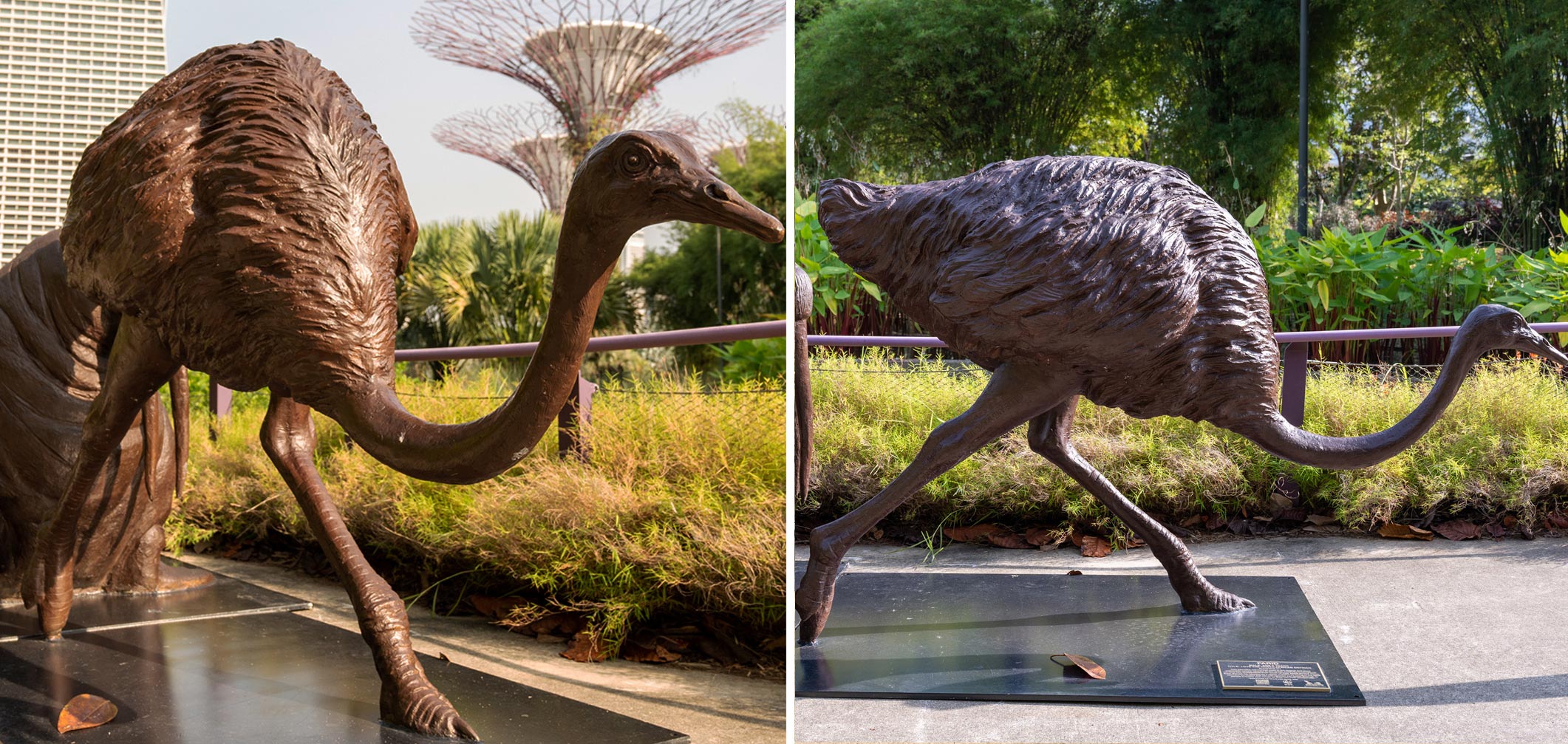North African Ostrich by artists Gillie and Marc
LOCATIONS
EDITION 1 - SINGAPORE - 19 May 2023 - 18 May 2024
Gardens By The Bay, 18 Marina Gardens Dr, Singapore 018953
Visit the sculpture, click for map >
__________________

CLICK HERE TO DONATE DIRECTLY TO WWF >
NAME
Farid
TITLE
Love The North African Ostrich
GENDER
Male
AGE
8
FOUND
West and North Africa
CONSERVATION STATUS
Critically Endangered
This 8-year-old male has a stunning neck. Bright and flashy in a pinkish-red hue, it contrasts with his rich black feathers making him a heart-throb on the savannah. But his beautiful soft feathers have made him a target, as have the huge eggs that his females lay. Once the most widespread of his kind, he is now critically endangered. He hopes that people can see past the common ostrich and their thriving populations and give him and his gorgeous subspecies a helping hand.
Also known as the red-necked ostrich and Barbary ostrich, this subspecies of the common ostrich is the largest living bird in the world. Standing on average at 2.74 m and weighing up to 154 kg, this bird is not to be trifled with, even though it can’t fly. The male has a pink-red neck with black and white feathers. The female North African ostrich is grey. Once the most widespread ostrich found across much of western and northeastern Africa in open fields and savannahs, it can now be found in only 6 of the original 18 countries it once roamed. This hardy bird is the only subspecies capable of living in the Sahara, living right around the periphery.
Ostriches are very fast, receiving the award for the fastest land speed for birds. They can run large distances at 55km/h and can push short bursts at 70km/h. With such powerful legs, these can also be used as effective weapons, particularly deadly with the sharp talons at the end. When threatened, the ostrich can choose to stand and fight or flatten itself on the ground. The idea that ostriches bury their head in the sand is a very ancient myth.
When it is time to mate, the birds begin to form small groups. A territorial male will defend their harem of between 2-7 hens and pair bond with the head female. The ritual of mating is quite the show with the male flapping his wings almost like a dance while the female runs around him. The dominant female of the group will lay her eggs in a nest in the ground and the other females will do so after her, keeping their eggs together before covering them up for incubation. Ostrich eggs are the largest of all eggs except the smallest relative to body size. The females incubate the eggs during the day and the males take their turn at night. When the chicks hatch, they are cared for by both their parents. They are full-grown at 6 months and are sexually mature at 2-4 years.
These ostriches have been in decline for the past 50 years. They have been hunted for their feathers, food, and eggs and have suffered from habitat loss. There is now an effort to reintroduce North African ostriches, particularly in northern Sahara where they have been extinct for the past 50 years. There have also been introduction programmes in Asia where their extinct cousin, the Arabian ostrich once roamed. Being very similar, the North African ostrich was considered a good replacement and has been introduced in Saudi Arabia and Israel but the project in Israel was unsuccessful.
HOW TO HELP
Inspired by animals that Gillie and Marc met on their travels, we invite the public to discover and interact with these beautiful creatures up close and personal – this allows audiences to connect, take photographs and share their favourite species with friends and family.
With more exposure comes more awareness and builds on the love we already have for animals around the world. With love comes a greater sense of urgency to create a change and save all endangered animals.
The sculpture will be aligned with the hashtag #LoveTheLast to raise unparalleled awareness about the sculpture’s cause across the globe.
To help protect these animals, please donate to the WWF: https://www.wwf.sg/
PARTNER
For more information, visit https://www.wwf.sg
ABOUT GILLIE AND MARC
Gillie and Marc’s highly coveted public artworks can be found worldwide including in New York, London, Singapore, Shanghai, and Sydney. They are Archibald Prize finalists, won the Chianciano Biennale in Italy, took out the Allens People’s Choice Award in 2016 and 2018 and Kids’ Choice Award in the 2016 Sculpture by the Sea and received the Bayside Arts Festival People's Choice Award in 2019 in Sydney.
The husband-and-wife duo are on a mission to make art for a better tomorrow. They are best known for their beloved characters, Rabbitwoman and Dogman, who tell the autobiographical tale of two opposites coming together as best friends and soul mates.
Gillie and Marc are also passionate eco-warriors and have dedicated their lives to protecting nature.
Gillie grew up with the wildlife in Zambia and Marc studied chimpanzees in Tanzania as a young man. Over time, the artists developed a deep appreciation for all living things and a desire to preserve the magnificence of the natural world.
Gillie and Marc’s mission is to save species from extinction. Through their practices, they are transforming passive audiences into passionate advocates for animal conservation, spreading awareness about endangered species and leading to change.
Their art has raised hundreds of thousands in donations for the many wildlife charities and causes they support through their project Love The Last.
Please follow @gillieandmarcart
If you are interested in buying art related to the Love the Last March, you will also be directly helping real animals in the wild, with 30% of sales going to WWF to continue their fantastic work for animal conservation. Click here to browse art > https://gillieandmarc.com/collections/love-the-last-march


